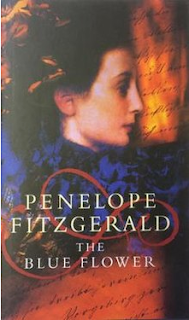The Blue Flower by Penelope Fitzgerald
The Blue Flower is a fictional recreation of the young adult life of Friedrich von Hardenberg before he became famous as the 18th Century German Romanticist poet Novalis. Starting with his college years, the novel gives a detailed glimpse of life in late 18th century Germany, and the development of the complex character of this Romantic mystic full of magical idealism who also develops a successful career in the salt mines of Germany. Central to the novel though is his idealized love for 12 year old Sophie von Kühn, who he hopes to marry when she turns 16. While most of his contemporaries describe her as plain and simple-minded, he sees beyond to her inner beauty.
The book opens with the young Friedrich bringing a friend home from college on Washday, the one day a year when the household washes all their linens and clothing. They have a year's worth of clothing and linens and wash them all once a year! The whole family is knee deep in dirty linens.
Families are big, and often mixed, as death comes frequently to the people of the time. Friedrich, being the eldest son and attending university, is the pride of the family and deeply involved in the philosophical ideas of the times. So it comes as a shock to his upper class family when he falls in love with a plain looking, simple-minded girl of 12 years from a large unruly working class background.
Fitzgerald mixes authentic details from letters and journals with wonderfully developed personalities of the family members to blur the distinction between biography and historical fiction and creates a world in which readers can immerse themselves. It is a small book with short chapters that is amazing and worthy of its accolades. It won the 1997 National Book Critics Circle Award, and William Skidelsky named it one of the ten best historical novels in a 2012 Observer article.

No comments:
Post a Comment